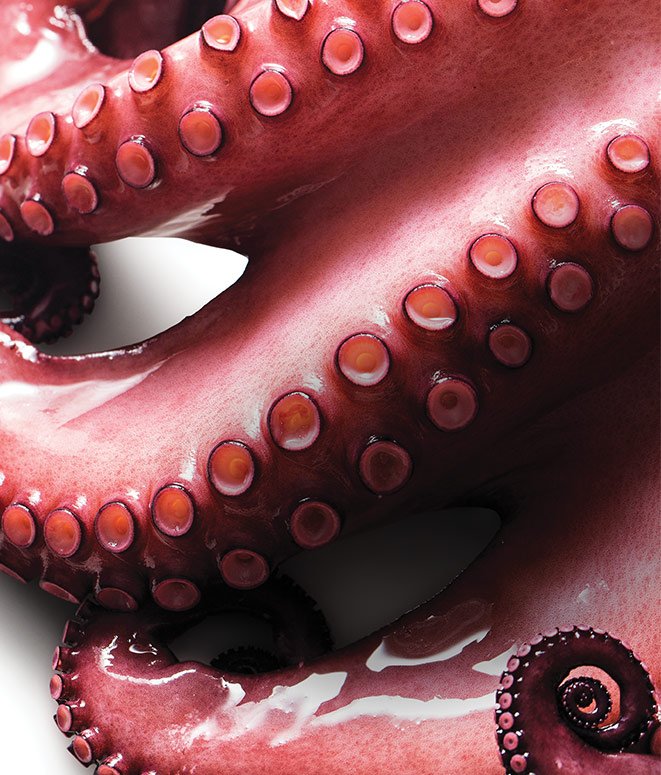Beloved for centuries by cooks in Greece, Portugal, Spain, and Italy, octopus has yet to make its mainstream debut in American kitchens—perhaps due to the fact that, if not prepared properly, it can turn into something more akin to a rubber eraser than an entree. And exhaustive internet searches do little to add clarity: We encountered tenderness-inducing techniques ranging from rubbing with a grated daikon to adding wine corks to the cooking water. The simplest, most surefire solution to perfect octopus every time? You guessed it—the sous vide method.
Whether you prefer to serve your octopus grilled, sauteed, or chilled and sliced atop a salad, it becomes irresistible when cooked sous vide—tender, succulent, with the pleasant velvety quality we typically associate with lobster. Read on for everything you need to know about preparing octopus sous vide, from what to look for at the seafood counter to helpful tips for prepping and finishing.
WHY SOUS VIDE?
Octopus tentacles are rich in collagen, which can make them tough and rubbery when cooked using traditional methods. But the low-and-slow process of cooking octopus sous vide transforms the collagen into gelatin, creating a tender, silky finished texture.
HOW TO SHOP FOR OCTOPUS
For the best flavor, it’s hard to beat fresh, wild-caught octopus from Spain or Portugal—but the price tag is significantly higher. For the home cook, frozen octopus is actually preferable over the fresh version, since freezing helps to break down the cellular structure. If you’re buying frozen, pay attention to the “product of” signs at the seafood counter to find a wild-caught option that hails from Spain or Portugal. Keep in mind that frozen octopus is typically available in pre-tenderized and non-tenderized varieties; the cooking time and temperature is different for each, as the pre-tenderized option will need significantly less cooking than the non-tenderized option.
THE QUANTITY QUESTION
Generally speaking, the bigger the octopus, the longer it takes to cook. A good rule of thumb is to look for an octopus weighing 2 to 4 pounds, which is less intimidating for a novice cook and looks more appealing when plated. In some cases, you might want a slightly larger octopus—for example, if you’re preparing sushi, you might want a more generous-sized slice.
HOW TO PREP OCTOPUS
We recommend the simplest prep possible—no blanching, marinating, or mysterious rituals necessary. Instead, just rinse the whole octopus several times to remove excess salt water and sand, then remove the beak using a knife or spoon. Add it to the sous vide pouch with just a pinch of salt—octopus is typically salty already, so don’t overdo it. Once it’s cooked, remove from the bag and use kitchen shears or a knife to separate the tentacles from the body. While the tentacles are often the main attraction, we recommend reserving the body for other purposes, such as chopped or sliced in a ceviche, paella, or bouillabaisse.
COOKING OCTOPUS SOUS VIDE
To achieve the best results with cooking octopus sous vide, we recommend following Thomas Keller’s lead from his book, Under Pressure, and cooking at 170.6°F (77°C) for 5 hours. Since everyone’s taste and texture preferences are different, you can try experimenting with cooking time: Cook a bit longer (up to an additional hour) for more tender results, or reduce the cook time to retain more of the structure. If you’re really up for experimentation, buy two and cook them in the same water bath for different lengths of time.
FINISHING A SOUS VIDE OCTOPUS
Ready for the ultimate key to successfully finishing your sous vide octopus? It’s all about drying the tentacles completely once you remove them from the sous vide bag. You can pat them dry with a paper towel, and even leave them in fridge overnight to dry completely.
As for finishing techniques, grilling octopus tentacles is an ideal way to add some savory crispness to contrast with the juicy, tender meat. Try searing them on a very hot grill, or in a cast iron or grill pan on the stove. You can also batter the cooked tentacles and deep fry for a satisfying crunch. Want to keep it simple? Just slice and add to soups or salads.
Related Articles VIEW ALL ARTICLES
Tips & Techniques
A Guide to Sous Vide Sauces
Every home chef should count these sous vide sauces among their kitchen secrets.
Read More >Tips & Techniques
5 Commandments of Sous Vide Cooking
Trying sous vide cooking for the first time? Learn how to do it right with helpful sous vide tips from the experts at CREA and Cuisine Solutions, the world-renowned masters of the method.
Read More >Tips & Techniques
Getting Started with Sous Vide
Trying sous vide cooking for the first time? Get the scoop on how to do it right with helpful tips from the chefs at Cuisine Solutions, the world-renowned experts in the sous vide method.
Read More >Cuisine Solutions’ Chief Scientist Dr. Bruno Goussault reveals his rules of the kitchen and takes questions from readers about the sous vide method.
Buy the Magazine
Buy NowDedicated to the Art & Science of Sous Vide
The first publication devoted to the art and science of sous vide cooking, featuring innovative recipes, visual inspiration, expert techniques for cooking sous vide at home, and exclusive interviews with world-class chefs.

